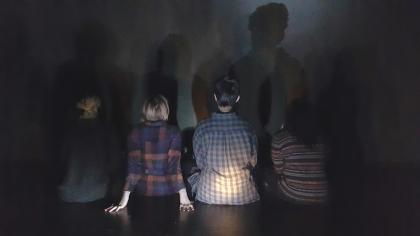

Between Feb. 18 and Feb. 20, Elena Marione ’16’s thesis production “Twine: After Troy” ran in Kirby Theater for a full house. The two words that best describe the production are “interactive” and “dynamic.”
Right away the interactive nature of the production was apparent to the audience: the play came to us, hushing the idle conversations in the lobby of Kirby in the form of a clear voice suddenly piercing through the crowd with emotive singing. The voice belonged to Philomela (Emily Willick ’18), who led a captivated audience into the main auditorium of Kirby to their seats, all the while still crooning her mournful song. Following behind her, surrounded by solemnly huddled people marching forward, I felt like a member of a funeral procession. Philomela led us onto the stage itself to a seating arrangement that blended into the decrepit aesthetic of the stage itself. Tree branches and debris littered the stage, the offstage seats and the floor. The audience was intimately brought into the disrepair that the lives of the four protagonists have fallen into.
The interactive element the play started out with wasn’t a cheap gimmick to draw us in; Marione committed to including the audience throughout the entire play. Actresses pinned audience members with intense eye contact while speaking, handed them artifacts to hold and shined lights onto them during the production to directly engage with them. The interaction itself was dynamic and so varied in intensity. At one point, an audience member had to move their leg to make room for an actress fishing beneath their chair for something. During another scene, in which the actresses drew the storyline of prerecorded audio that played during the show, Philomela settled in front of me and drew a picture that I could see clearly, while I could only see Hecuba’s (Mahalia Banton ’19) back as she drew for other members of the audience.
The interactivity of some parts of the play and not others was one of the many ways that the play was extremely dynamic. The primary evidence of this dynamism lied in the structure of the piece: it was broken up into several styles and different methods of storytelling. In the beginning of the show, Hecuba launched into a soliloquy, but the show contained everything from a delightful use of stage lighting and bodies for shadow play on the back wall of the stage to a short period of silence from the women, preoccupied by their props. The emotions and themes of the show were elaborated on by the variation in the content of the show, but there was not a “storyline” in a traditional sense, and the show’s structure changed every two minutes or so.
Dynamism abounded in many other aspects of the show as well. Speech was sometimes sustained for extended periods of time and came in quick, choppy bits. The women onstage screamed in fits of passion, but other times left the stage tense and silent. Characters shifted position often and took advantage of all the space available onstage; at some points they clustered together and occupied small areas, while in other moments they spread out so far from each other that they seemed self-contained. Furthermore, the characters themselves seemed to be different parts of a whole — Hecuba, a maternal figure focused wistfully on the past; Cassandra (Alina Burke ’17), an eccentric toeing the line of mental illness; Andromache (Darienne Madlala ’16), a romantic prone to fantasy and hope; and Philomela, an impassioned woman full of anger. Despite being very distinct individuals, they all seem to exemplify women who emerge out of strife.
The process behind writing the story sheds some light on the masterpiece that is “Twine.” Rather than approaching actresses with a readymade script, Marione opted for a collaborative process known as “devised theater” — Marione, Banton, Burke, Madlala and Willick collaborated on the final product during rehearsals. Marione led the process with text, myths and images that the four actresses and herself used as prompts for improvisational scenes, games and movement exercises. At the end of the process, Marione selected the ideas that worked best and polished them before situating them in the final product.
Marione said she is “lucky to discover such dedicated and enthusiastic performers.” She began by searching for a cast that all identified as female and unearthed a team that was willing to participate in the creation of the production through trial, error and play. Dynamism is part of the very fabric of the play; it was only through the interaction of four women from very different backgrounds that “Twine” was finally born (notably, the women were all cisgendered and present, thus a limited view of womanhood).
The time and thoughts Marione invested in the show paid off, as all of the actresses in the play gave evocative performances that conveyed raw emotion that goes beyond what simple language can say. In writing “Twine,” Marione set out to convey a story about “womanhood, grief, strength and survival.” And besides the special electric feeling one gets when being interacted with by an actor and the excitement of a dynamic stage, Marione gave her audience something extremely powerful with her thesis project: an unadulterated, unrestrainedly emotional look into the collective suffering of women.